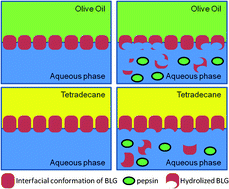Protein unfolding at fluid interfaces and its effect on proteolysis in the stomach
Abstract
Rational design of

* Corresponding authors
a
University of Granada, Department of Applied Physics, Campus de Fuentenueva sn, Granada, Spain
E-mail:
julia@ugr.es
Fax: +34 958 243214
Tel: +34 958 241000 ext 20387
b Institute of Food Research, Norwich Research Park, Norwich NR4 7UA, UK
Rational design of

 Please wait while we load your content...
Something went wrong. Try again?
Please wait while we load your content...
Something went wrong. Try again?
J. Maldonado-Valderrama, P. J. Wilde, F. Mulholland and V. J. Morris, Soft Matter, 2012, 8, 4402 DOI: 10.1039/C2SM07317J
To request permission to reproduce material from this article, please go to the Copyright Clearance Center request page.
If you are an author contributing to an RSC publication, you do not need to request permission provided correct acknowledgement is given.
If you are the author of this article, you do not need to request permission to reproduce figures and diagrams provided correct acknowledgement is given. If you want to reproduce the whole article in a third-party publication (excluding your thesis/dissertation for which permission is not required) please go to the Copyright Clearance Center request page.
Read more about how to correctly acknowledge RSC content.
 Fetching data from CrossRef.
Fetching data from CrossRef.
This may take some time to load.
Loading related content
